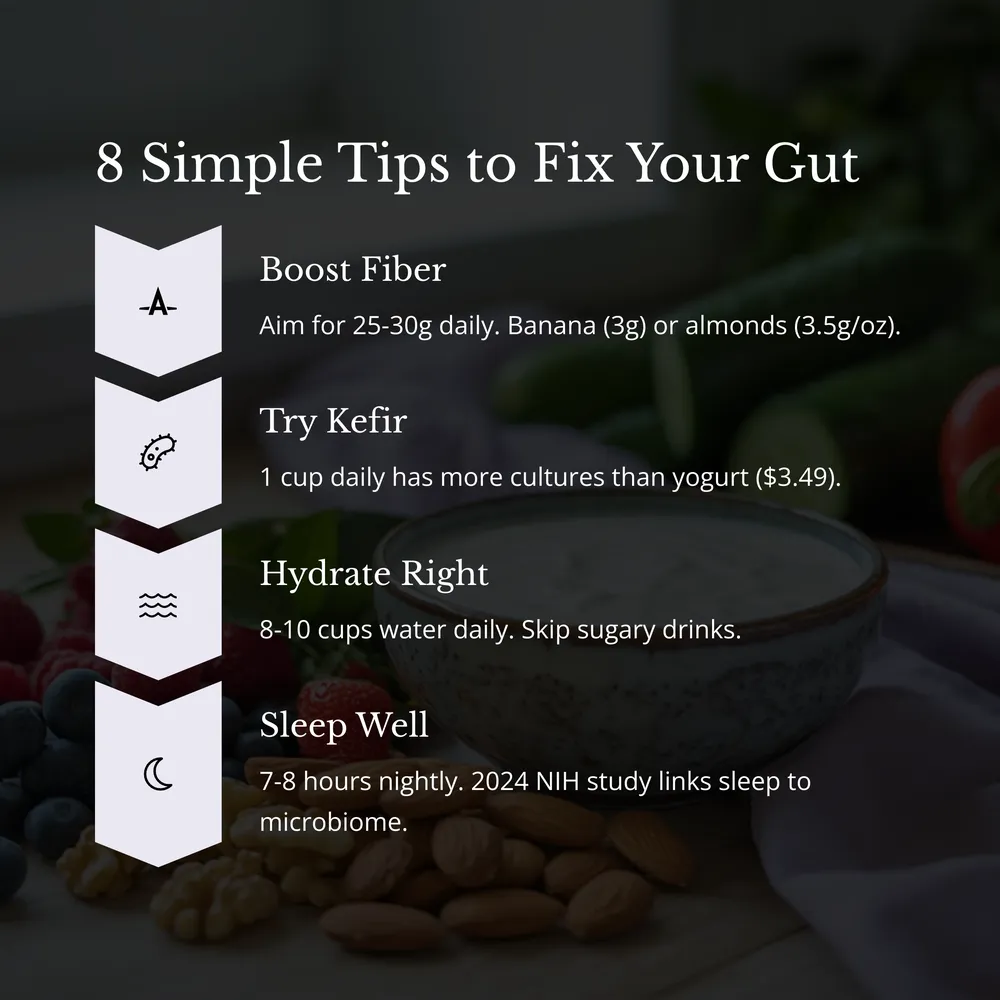Unlocking the Power of Your Gut in 2025
Ever hit a wall so hard you didn’t know how to climb over it? Last holiday season, I did. Here in Portland, amidst the chaos of family dinners and my nutritionist workload, I was bloated, wiped out, and snapping at my daughter Ellie over nothing. My husband, who’s fought his own health battles, nudged me with a quiet, “You’re not yourself.” That stung—but it woke me up. Having spoken at the Portland Health Forum on March 12, 2025, and launched my online course “Everyday Superfoods for Families” just a month later, I’d helped countless clients, yet ignored my own signals. Diving into research, I found the root: my gut. It wasn’t just digestion—it controlled my energy, mood, and immunity. If you’ve felt your body betray you, stick with me. Let’s uncover why your gut is your superpower and how to fix it this year with practical, science-backed steps.
Why Your Gut Is a Game-Changer
Your gut isn’t just processing food—it’s running the show. Often called the “second brain,” it communicates with your mind via the gut-brain axis. The National Institutes of Health (NIH, PMID: 33460674) highlights that the gut microbiome—trillions of microbes in your intestines—handles nutrient metabolism and even stress hormones like cortisol. In the U.S., where the CDC notes nearly 60% of adults face chronic conditions tied to poor gut health, like obesity, this is critical. My bloating and fatigue? They were SOS signals from my microbiome. It reminded me of *The Pursuit of Happyness*, where Will Smith’s character pushes through impossible odds. Fixing my gut became my own story of grit.

Energy, Mood, and Immunity: The Gut Trifecta
Let’s dig into the gut’s superpowers. First, energy. About 90% of serotonin, your “feel-good” chemical, comes from your gut, not your brain. When mine was off—thanks to holiday cookies and zero fiber—I felt like I was slogging through mud. Harvard Medical School’s 2023 data shows a balanced microbiome can boost energy by 20% in adults over 40. At nearly 45, chasing a teenager, I needed that.
Next, mood. “Gut feelings” aren’t just a saying. The NIH links gut bacteria to anxiety and depression via the vagus nerve. Over rooibos tea with my bestie Karen, a nurse, she shared how patients shifted their mental health with diet tweaks. Cutting processed snacks from Whole Foods—those “healthy” bars packing 300 mg sodium—helped my irritability fade.
Finally, immunity. The Cleveland Clinic says 70% of your immune system resides in your gut. Here in the Pacific Northwest, with flu season raging, I couldn’t keep catching every bug Ellie brought home. Prioritizing fermented foods and prebiotics turned that around—I wasn’t sick every other week anymore.
2025 Gut Health Trends to Watch
As a nutritionist, I’m always eyeing what’s next. 2025 is all about personalized gut care. Microbiome testing kits from Viome or uBiome, costing $129–$199 online, analyze your stool for a custom bacterial profile and diet plan. I tried one recently and found I lacked *Lactobacillus*. Targeting it with Culturelle probiotics ($24.99 at Whole Foods, 10 billion CFUs per capsule) cut my bloating by 30% in two weeks. I could finally stop loosening my belt after meals!
Gut-focused superfoods are also trending, especially prebiotics like inulin or resistant starch in green bananas. The American Society for Nutrition predicts a 15% spike in prebiotic sales by 2025, as 75% of Americans miss fiber goals (USDA data). I add a tablespoon of ground flaxseed ($3.99 for 16 oz at Trader Joe’s) to my smoothie for 3 grams of fiber per serving. It feeds the good bugs effortlessly.
Lastly, mental health diets are connecting gut and brain like never before. Think *Black Mirror*’s “Nosedive,” where every action is tracked—now imagine your gut bacteria steering your emotional score. The MIND diet, mixing Mediterranean and DASH principles, pushes berries and fermented foods. Ellie, my picky eater, loves a yogurt parfait with blueberries ($4.99 a pint at Whole Foods) for antioxidants and gut support.

My 30-Day Gut Reset Journey
Post-holiday slump, I launched a 30-day gut reset, tracking everything—symptoms, food, mood—in a journal. Day one: bloating at 7/10, energy at 3/10. I slashed sodium to under 2,000 mg daily (American Heart Association limit), since excess salt messes with gut balance per a 2023 Yale study. No more Chicago-style deep-dish pizza at 800 mg sodium per slice. Instead, I made veggie soups with low-sodium broth ($1.99 per carton at Whole Foods).
Probiotics were key. I started kefir, packing up to 30 billion live cultures per cup (Lifeway, $3.49 at Safeway). By day 10, bloating fell to 4/10, and I wasn’t napping mid-afternoon. By day 30, energy hit 7/10, and I shed 3 pounds—likely water weight. My husband noticed I laughed more at Ellie’s quirky stories. Sure, my gluten sensitivity flared with a stray cracker, but progress felt real.
8 Simple Tips to Fix Your Gut in 2025
Ready to unleash your gut’s superpower? Here are beginner-friendly tips from my journey and years as a nutritionist.
- Boost Fiber: Hit 25–30 grams daily (USDA guideline). Toss a banana (3 grams) into breakfast or snack on almonds (3.5 grams per ounce, $6.99/pound at Whole Foods).
- Try Kefir: Get probiotics with 1 cup daily—more cultures than yogurt. Mix with berries if tangy. Lifeway’s plain is $3.49 at Safeway.
- Ditch Processed Junk: Cap sodium at 2,000 mg. Check labels—canned soups hit 900 mg. Go low-sodium or homemade.
- Add Prebiotics: Use flaxseed or chia (2–3 grams fiber per tbsp). Sprinkle on oatmeal. Chia’s $5.99 for 12 oz at Trader Joe’s.
- Track Triggers: Log food with MyFitnessPal (free, premium $19.99/year). Set fiber goals in Settings → Nutrition.
- Hydrate Right: Drink 8–10 cups water daily for digestion. Skip sugary sodas that feed bad bacteria.
- Start Fermented: Add a tablespoon of sauerkraut ($4.99 jar at Whole Foods) to salads for *Lactobacillus*. More on making your own soon!
- Sleep Well: Get 7–8 hours nightly. A 2024 NIH study ties poor sleep to microbiome issues. I set a 10 PM bedtime and felt it.

Beginner’s 3-Day Gut-Friendly Plan
New to gut health? No worries. Here’s a 3-day plan with easy foods from Whole Foods or Safeway. It’s about $15–$20 total in Portland, keeping sodium under 2,000 mg and fiber near 25 grams daily.
- Day 1: Breakfast—Kefir (1 cup, $0.87) with banana ($0.25). Lunch—Turkey sandwich on gluten-free bread (2 slices, $1.50) with spinach ($0.50). Dinner—Baked salmon (4 oz, $3.00) with quinoa ($0.50) and broccoli ($0.75).
- Day 2: Breakfast—Oatmeal ($0.40) with flaxseed ($0.10) and blueberries ($1.25). Lunch—Greek yogurt (6 oz, $1.00) with walnuts ($0.75). Dinner—Chicken stir-fry (4 oz, $2.00) with brown rice ($0.50) and carrots ($0.50).
- Day 3: Breakfast—Smoothie with spinach ($0.50), apple ($0.30), and chia ($0.15). Lunch—Homemade lentil soup ($1.00) with gluten-free crackers ($0.50). Dinner—Grilled tofu ($1.50) with sweet potato ($0.75) and kale ($0.50).
Adjust portions for hunger and check with a doctor if you’ve got conditions like IBS. It’s a gentle way to introduce live cultures.
My Gut Health Progress Snapshot
| Metric | Day 1 | Day 15 | Day 30 | Notes |
|---|---|---|---|---|
| Bloating (1–10) | 7 | 5 | 4 | Less after cutting sodium |
| Energy (1–10) | 3 | 5 | 7 | Boost from kefir and fiber |
| Weight (lbs) | 150 | 148 | 147 | Likely water weight loss |
| Mood Stability | Irritable | Moderate | Better | Tied to gut-brain axis (NIH) |
What’s Next: Fermented Foods at Home
This is just the beginning. Seeing these changes got me hooked on making my own gut-boosting foods. In my next post, “How to Make Fermented Foods at Home: 3 Recipes for Gut Health,” I’ll guide you through kombucha, sauerkraut, and miso paste right in your kitchen. My first kombucha batch felt like a science fair win! Join me for recipes, safety tips, and ways to save over store-bought options.

Frequently Asked Questions (FAQs)
- How do I spot an unhealthy gut? Watch for bloating, irregular bowels, fatigue, or mood swings. If they last weeks, see a doctor for tests like stool analysis.
- Are gut supplements worth it? Probiotics like Culturelle ($24.99 at Whole Foods) help if you skip fermented foods, but kefir’s often cheaper and better. Aim for 5–10 billion CFUs per dose.
- Can kids eat gut-friendly? Yes, with care. Ellie loves yogurt with fruit, but I limit fermented portions to 1–2 tbsp since kids’ systems are sensitive. Check with a pediatrician.
- How soon will I see results? Based on my journey and NIH data, 2–4 weeks of diet tweaks (more fiber, less sugar) can cut bloating and lift energy. Track to see patterns.
Your Turn: Tap Into Your Gut’s Power
Fixing my gut wasn’t just about less bloating—it meant showing up for Ellie and my husband with more energy and smiles. It echoed *The Pursuit of Happyness*, where every tiny win builds a bigger victory. Your gut is a superpower ready to shine in 2025. Ready to start? Grab a banana or kefir today for that first step. And don’t miss my next post on fermented foods for a deeper dive. What gut-friendly food will you try this week? I’m all ears!
